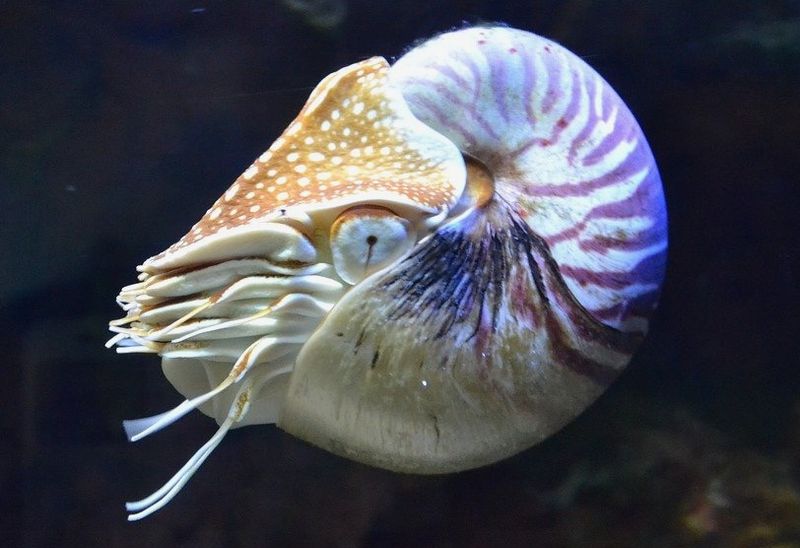The Nautilus: Science and Symbol
The chambered nautilus is an ancient species, originating some 500 million years, long before mammals roamed the land and sea, and even well before the dinosaurs. Found only in the remote Pacific, the remarkable shape, colour, and rarity made it a prized collector’s specimen in Darwin’s time. It also inspired the name for the first working submarine (c.1800 by Robert Fulton) and the better-known fictional submarine of Jules Verne (1871). It is now on the verge of extinction because of climate change.
Extinction:
The remarkable shape of the nautilus is a function of its growth process. As the nautilus organism matures, it builds succeeding chambers, living in the largest and using the former chambers for buoyancy control. The resulting shell is magnificently geometric, in the form of a perfect spiral. The shape is commonly described as a golden spiral, one that follows from the properties of the Fibonacci sequence and the remarkable mathematics of the number phi (φ). The creature and shell are stunningly beautiful.
In a recent article in the eponymous “Nautilus” magazine, writer, and researcher Peter Ward, describes his personal experience studying the nautilus over the past three decades. His message is clear:
“In less than a century, climate change has upended conditions that have sustained life in the Mesophotic Zone for millions of years. Global warming, generated by human activity, has penetrated surface water and caused the water in front of reefs to become lethally warm and anoxic…”
“Although the nautilus doesn’t face as many predators… humans have reduced their numbers…. [but] the buoyant, deep-sea organism with the beautiful spiral shell faces a bigger problem. The water temperature in the ocean layer, defined as the Mesophotic Zone, through which the nautilus travels, is growing so warm that it’s destroying the life of all the organisms that thrive there… The nautilus is the prototypical animal in the Mesophotic Zone. Its survival now foretells the fate of the oceans’ ecological health.”
Sidebar: The Mathematics of the Nautilus
In the comment section of the Nautilus article, I had an exchange with Christopher Bartlett. In my comment, I repeated the ubiquitous claim that the Nautilus shell demonstrated the remarkable beauty of the golden ratio and the number phi (φ). This is a topic I have written about in several posts (see: Spirals and Phi). Christopher, however, corrected me, pointing out that the claim regarding a connection between the nautilus and the golden spiral was a myth that has been disproved, although it continues to be widely repeated.
Christopher is the author of a detailed report on the measurements and mathematics of chambered nautilus specimens around the world: Nautilus Spirals and the Meta‐Golden Ratio Chi. His meticulous and detailed references, drawings and calculations confirm the inaccuracy of the myth that the nautilus shell spiral was an example of the golden ratio phi (φ), the ratio that divides a golden rectangle into a square and a smaller golden rectangle. It is, however, patterned on a logarithmic spiral (as is the golden spiral), but with a geometric ratio, on average, close to 1.31. Phi (φ) is approximately 1.618.
Remarkably, one of the six known species of nautilus, the rare “crusty nautilus”, diverges in its proportions from the other five species, and demonstrates a geometric ratio of 1.35566, extremely close to the number chi (χ) – 1.35567. Chi (χ) is known as the Meta-Golden ratio, as it divides a meta-golden rectangle into a golden rectangle and a smaller meta-golden rectangle.
Christopher points out that “all of the specimens are natural forms with inherent biological variability and will not conform perfectly to strict mathematical parameters. Although Nautilus chamber growth follows overall exponential trends, some allometric discontinuities occur due to adverse ecological conditions (e.g., water temperature and pH) as well as in very early and late ontogeny (e.g., the last chamber is reduced in volume) …. The Nautilus simply follows its genetic imperative growing gracefully larger without changing shape.”
The article includes an extensive discussion of how the golden ratio myth arose and came to dominate the public conversation and a review of the unusual physiology of the nautilus. He offers a more extensive discussion of the meta-golden ratio and its appearance in art and architecture and notes that chi (χ) and phi (φ) are both close to the 4:3 ratio also referenced in studies of art and perspective. The 4:3 ratio in decimal form is 1.333.
Conclusion:
Some might argue that the mathematical details of nautilus shell geometry is about as interesting as the trope about how many angels could dance on the head of a pin. In practical terms, those shells and the creatures that build them are all fascinating and beautiful.
It is also terrifying to think that the choices made by humans in the last 100 years is now about to destroy a species, with such a remarkable, beautiful and iconic shape, that has lived for 500,000,000 years.
Do you think there is time to reverse course?






